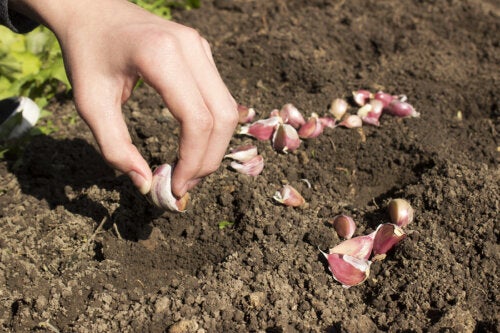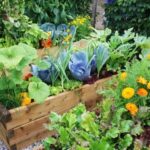Garlic is a food with interesting uses in gastronomy and the home. This time we tell you how to grow it at home in simple steps. You dare? Discover everything you need to keep in mind.

Garlic is a member of the Allium family, of which onion and leeks are a part. It is one of the most popular spices in what has to do with gastronomy, since it provides a very special flavor and aroma to food. Also, growing garlic at home is very easy and requires little space in the garden.
As you may know, garlic grows from individual cloves, separated from a whole bulb. Each of these teeth can multiply again in the soil, giving rise to a new bulb with 5 or 10 teeth. Best of all, stored in a cool and dry place, it is a food that will keep for months.
Do you want to learn how to grow garlic at home? So that you have no doubts, we are going to do a brief review about its properties and we will share all the steps so that you can sow and harvest it. Take note!
Why grow garlic at home?
Many people have decided to make their own gardens at home, as it is a simple and inexpensive way to obtain organic food, free of pesticides. Among these, growing garlic is a favorite as it does not require too much care and has many uses around the home.
And it is that, beyond its particular flavor, garlic concentrates important nutrients that contribute to improving the quality of the diet. This food contains:
- Water (62–68%).
- Carbohydrates (26–30%).
- Proteins (1.5–2.1%).
- Amino acids (1.0–0.5%).
- Organosulfur compounds (1.1–3.5%).
- Fiber (1.5%).
This same research suggests that garlic has the potential to prevent metabolic disorders and dyslipidemia. Likewise, its moderate consumption contributes to improving certain gastrointestinal functions, providing a protective effect for the defense of the mucosa against the activity of Helicobacter pylori and the development of ulcers.
Now, you have to consider how it is used, since when cooked it can lose a large part of its properties. Therefore, if the objective is to take it for health purposes, it is advisable to consume it raw, either alone or in combination with lemon juice.
How to grow garlic at home?
Growing garlic at home is really easy. All it takes is patience and choosing the variety. Once decided, you must also choose a suitable pot, since its roots are deep.
To grow garlic at home you need:
- 1 head of garlic.
- 1 pot 20 centimeters deep.
- Potting soil.
Instructions.
- Choose a head of garlic of the variety you prefer and separate the cloves, leaving the rind intact.
- Choose a suitable pot that has drainage, so that it can evacuate the excess water when watering.
- Fill the pot with enough soil, leaving at least an inch before reaching the edge.
- Bury the garlic cloves in the pot, at least 4 inches deep and with the pointy side up.
- In the pot you can put more than one clove of garlic, as long as they are separated by at least 8 centimeters from each other.
- Garlic buds will start to come out 16-32 weeks after planting, depending on the climate and variety.
Care that you must take into account.
The best time to start growing garlic at home is when the temperature is warm. Regions with climates that are too hot or too rainy are not the most appropriate for growing this bulb. In fact, from the beginning to the middle of the crop, a cold climate is required, the ideal temperature being from 0 °C to 15 °C.
After this, the temperature can reach up to 25 °C for the heads to reach maturity. The general recommendation is to start sowing in the fall or winter.
However, irrigation should be moderate, since too much humidity can affect the development of diseases. In addition, the plant should be kept free of weeds and, if possible, fertilized with a little compost every month.
The garlic harvesting process is done when the oldest leaves begin to dry out. To do this, the entire plant is extracted, without removing the leaves, preferably on dry and sunny days. Then the bulb is allowed to dry in full sunlight for a couple of days.
When the bulb is completely dry, it can be stored in a cool, dry place. If you prefer, you can preserve it with other methods such as dehydrated or pickled. Do you dare to do it at home?


